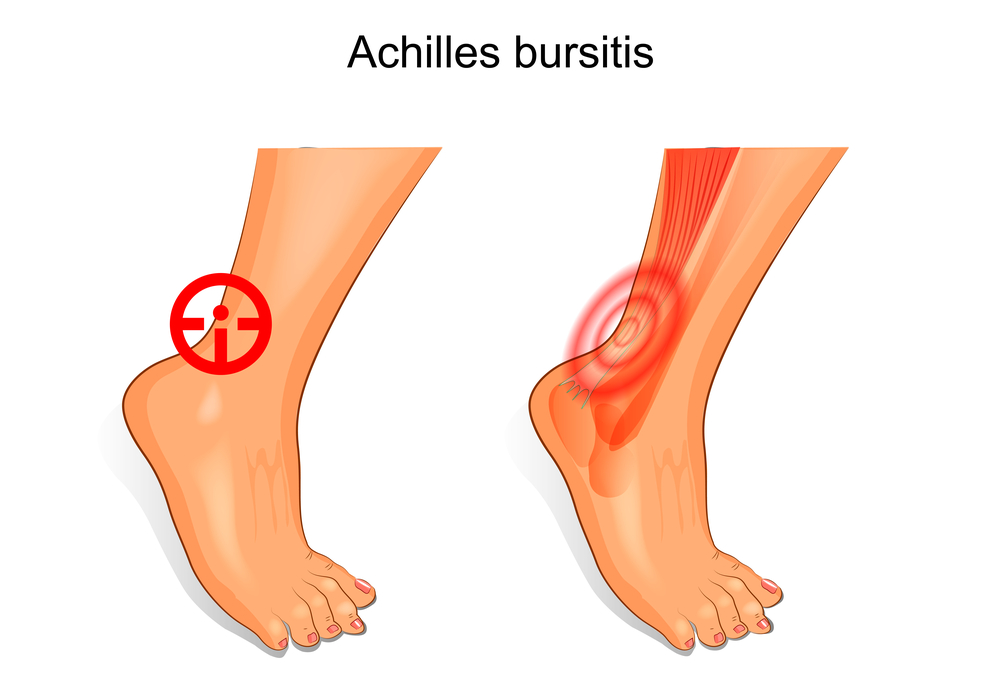The Achilles tendon attaches the calf muscle to the heel bone. The bursa are what cushions this tendon, and when these fluid-filled sacs become inflamed, the result can be painful. If you have been diagnosed with Achilles Bursitis, the recovery period can vary. At Island Foot Clinics in Kelowna, Nanaimo, Campbell River, Prince George, Terrace, Williams Lake, and Victoria, BC, we often see patients with this problem, and the prognosis is usually very good.
The Recovery Timeline for a Heel Bursa Injury
When Achilles Bursitis, also known as heel bursitis, is diagnosed and treated early, patients can expect to resume normal, pain-free activity within a few weeks. However, if the pain is ignored and the patient continues to put pressure on the heel, this can significantly extend the recovery timeline and lead to more severe injury. Following the treatment plan prescribed by your doctor is essential to ensure a quick and complete recovery.
Early Steps to Avoid Complications
Elevating the foot, applying ice, and taking anti-inflammatory medication as directed by your doctor can help to ease the pain of an inflamed bursa sac. Even if you are starting to feel better, it is very important to give your foot a break for about two weeks so that the damaged bursa has a chance to fully heal. Returning to an exercise routine too soon can cause a major setback.
When to Return to Normal Activities
If your heel feels completely pain-free at the three-week mark, it should be fine to begin a gradual return to normal physical activity. “Gradual” is key – jumping back into a five-mile run is not recommended! If you feel that your heel is starting to become tender again, this is a sign that you should immediately ease up on the physical activity.
If this condition has not resolved itself within a few weeks, your doctor may discuss other options with you. A corticosteroid injection, orthotics, special shoes, or physiotherapy may be considered. In extreme cases, there are surgical options for bursitis that has become chronic or debilitating.
What Causes Achilles Bursitis?
Achilles Bursitis is typically an overuse injury, resulting from too much running, jumping, or even walking. This is why we most often see it in athletes, although anyone at any age can develop this painful condition. A sudden upswing in your activity level, particularly when this is done without adequate stretching or warming up, can increase your risk of irritating the bursa sacs that are located on either side of the heel tendon.
While there are dozens of fluid-filled bursa sacs all over the body, the two that are located in the heel area are particularly prone to damage. This is a part of the body that handles a great deal of impact and pressure, so it is no wonder that the heel bursae are more likely to become inflamed. Thankfully, this is a very common condition that usually responds well to basic home treatments.
Symptoms of Heel Bursitis
If you begin to notice pain at the back of your heel, particularly when running or power walking on an incline, this is a warning sign that should not be ignored. You might find that the discomfort worsens when standing on tiptoes. In some cases, there may be swelling, but there is often no visible sign of injury.
The Two Different Types of Heel Bursitis
“Retrocalcaneal” is the most common type of heel bursitis, which affects the deeper of the two bursa sacs located between the Achilles tendon and the calcaneus. The second bursa sac, called the “Subcutaneous Calcaneal” bursa, is located closer to the skin.
Whether one or both bursae are inflamed, you will feel pain at the back of the heel that sometimes extends into the ankle. However, the treatment your doctor recommends might differ slightly depending on which type of bursitis you have. This can be determined with an x-ray and physical exam.
Not to be Confused with Achilles Tendonitis
Pain at the back of the heel can sometimes indicate tendonitis, as opposed to bursitis. The symptoms may be very similar, which is why it’s important to be examined by a doctor so that you know exactly what condition you are dealing with. Tendonitis is an injury to the tendon itself, as opposed to a bursa near the tendon. Both conditions are usually caused by overuse without adequate stretching and warming up prior to intense physical activity.
Treating Heel Bursitis
Relieving pressure on the heel is the first immediate step you should take if you think you might have bursitis. Keeping your foot up as often as possible and using cold therapy a few times per day is often all that is needed to ensure a full recovery. If you find that your heel is very tender, wearing an open-back shoe can also be helpful.
If you live in Victoria, BC, or in many other cities in the province, you can access our expert team of specialists to help get you quickly on the road to recovery. While treating a very mild case of bursitis at home is often possible, getting a medical opinion to confirm exactly what type of injury you are dealing with is always recommended.
When Bursitis is Advanced
In more severe cases, or cases that do not appear to be healing with regular home care, your doctor may recommend a steroid injection to give the area an immediate anti-inflammatory boost. An x-ray may be needed to determine exactly which bursa sac is injured, and to see if there is also tendinitis occurring in conjunction with bursitis.
When there is both bursitis and tendonitis present, your doctor may recommend completely immobilizing the foot is a cast until the area heals. Surgery is an absolute last resort, but if all other treatments have failed, your doctor might discuss the option of a Bursectomy with you. This procedure removes the damaged bursa sac entirely.
Preventing Heel Bursitis
Thankfully there are several things we can all do to help avoid this painful condition. Maintaining ankle flexibility and strength through stretching and exercise is essential. Performing a gentle stretching and warm-up routine before engaging in any intense exercise is a must. Wearing shoes with good arch support will also help to minimize the amount of stress placed on the tendon and bursae during exercise.
If this is your first case of bursitis and it is quite mild, you will likely be able to prevent future recurrences by engaging in some basic self-care and being mindful of not overdoing it when exercising. This is a fine line, because being physically active is of course critical to maintaining strength and flexibility in the foot and ankle. The key, as with all things, is moderation.
Finding the Best Podiatrist in Victoria, BC and Throughout British Columbia
Working with the best team of podiatric physicians (and, if needed, podiatric surgeons) is key to ensuring a complete recovery from any foot injury you may have. Contact us today at Island Foot Clinics if you would like to book a consultation with one of our highly skilled specialists. We now have clinics located in Kelowna, Nanaimo, Campbell River, Prince George, Terrace, Williams Lake, and Victoria, BC. We will help you develop the best treatment plan for you.

